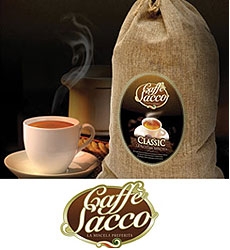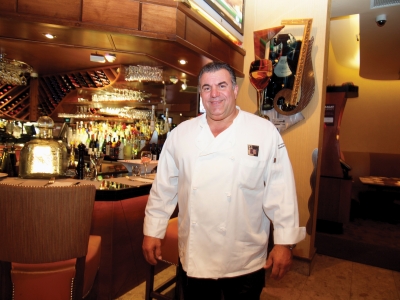
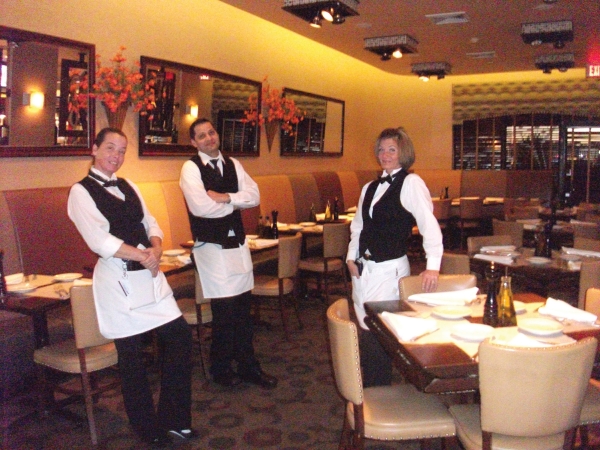
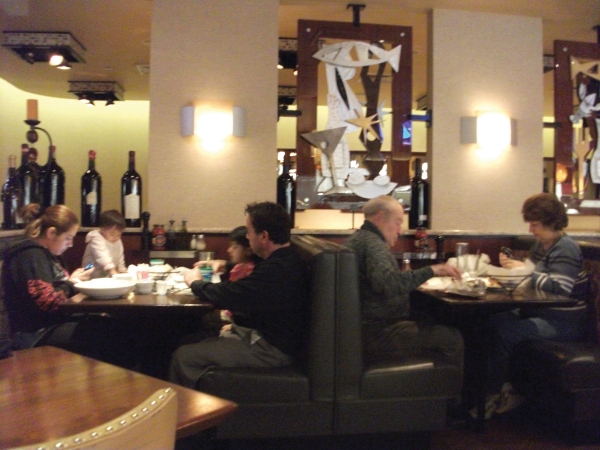
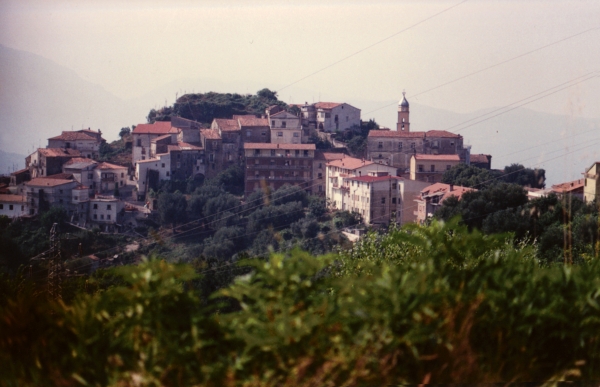
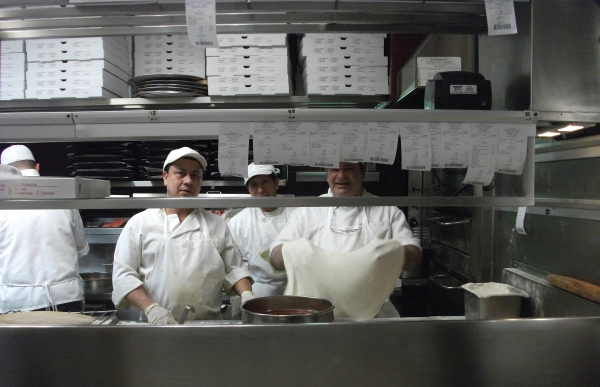
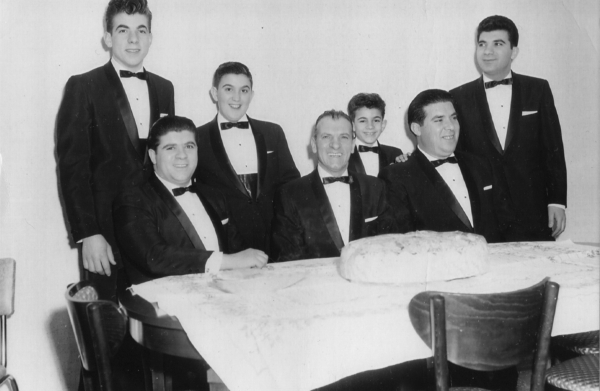
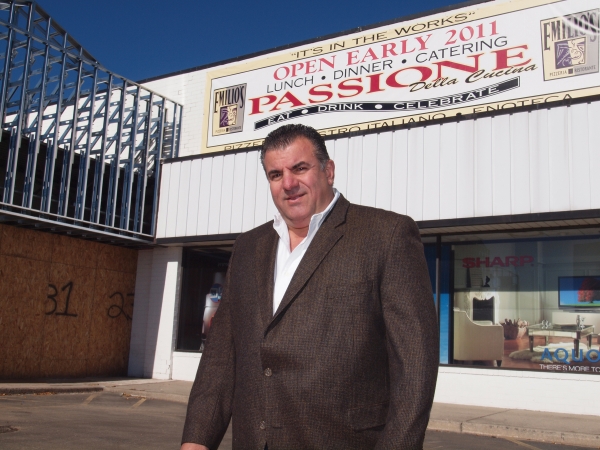
Holding Hands with the Pioneers of Pizza
By: Maria Orlando Pietromonaco
Emilio’s Restaurant & Pizzeria has been gracing the town of Commack with its old-world Italian charm since 1980.What started as something to do in the winter, as Emilio Branchinelli worked making Italian ices in the summer months, is now a flourishing Italian restaurant and pizzeria with a steadycrowd and impeccable surroundings. It has become a “pizza” staple in Western Suffolk county, with many a customer willing to add a few more miles to their drive to be able to sink their teeth into an authentic Emilio’s pie.
The restaurant is meticulously run by Emilio himself. In 1990, he split with allfamily members and decided to make a go of it alone. He developed an eclectic type of menu that was different than regular classic food, which is still today “our favorite tomake and is the biggest seller,” he says. He created contemporary recipes, though always keeping pizza in the mix, and he also hired a team of interior designers who renovated and decorated the space to his liking.
Emilio has assembled a talented lineup to run his restaurant. His
staff is efficient and courteous, always ready to greet with a smile. Cleanliness is of utmost importance, with “crisp, clean, stainless steel” décor that reverberates with purity and freshness. Their menu is “massive,” as Emilio puts it, abundant with “delicious, innovative dishes with oldstyle standards.” But impressively, with as many selections as there are, everything is still made to order — even their manicotti. This is made possible by the small army of employees working in the kitchen and in the foreground — as many as 40 at any given moment.
The recipes are a mélange of traditional dishes and Emilio’s creations. He invents his own pasta entrées and other Italian dishes that are distinctive and unique. “I myself make each and every recipe through inspiration,” he explains. “When an idea comes to me, I make it happen.” Some customer favorites include the eggplant rollatini, calamari arrabiatta, and rigatoni Napolitano.
Emilio is the product of a culinary regime, growing up in the restaurant business amongst family, friends, and mentors. “I’m the evolution of a lot of different people,” he says. “I’ve learned from people who are better than me.”
What drives Emilio most is his passion for food. He loves to eat, especially pizza, and he loves to learn. Who else would be able to recite the history of pizza? Emilio knows all about its heritage. From its inception in Italy to its journey overseas, he’s a wealth
of knowledge about this round culinary gem we call pizza.
“In 1880 in Italian home kitchens and bakeries, cooks used dough leftover from bread making and made what we now call “pizza” in brick ovens. When I went to Italy I saw these ovens in their kitchens. Everyone had one in their kitchen. The original pizza was prepared for Italy’s King Umberto as well as the Queen consort, Margherita of Savoy, by Raffaele Espositousing the colors of the Italian flag: tomato sauce for red, mozzarella cheese for white, and fresh basil for green. Needless to say, the Queen fell in love with this newfound creation,
as we know it today, the Margherita Pizza.
Back in 1903, the inspired Gennaro Lombardi made his way to Little Italy and opened the first known pizzeria. One of his employees, Antonio Totonno of the famous Totonno’s of Coney Island opened the second pizzeria, which still stands today. From there, Peppe’s of Connecticut made famous theclam pizza.
From Italy’s most beautiful mountaintop in Positano in a town called Mondo Pertuso, came the Aiello family who migrated to New York to open the first known mozzarella factory. Actually, my father, Gino, worked for them producing mozzarella, which was then put under government control to force them to pasteurize the cheese, now to be called “cubed pizza cheese.”Then the Bari family manufactured thermostatically controlled pizza ovens. With these products, a cousin of my father, Luigi Lamonica, teamed up with a guy called Mastro. Mastro sold pizza ovens to people like my father Louis Gino Branchinelli and other pizza pioneers such as Lenny Schiano,Ralph Pagano, and Joe Alfeo. You could still smell the pizzas a mile away when these first came out of these pizza ovens sold by Mastro and made for him by Baker’s Pride, who isa leader in the field today.
The Italians and other people that migrated to New York came here from Ellis Island, and before I was even born there were groups of people like Johns, Reds, Patsy’s, Lombardi’s,Grimaldi’s, Tortones — these were people that first landed here and tried pizza selling, which became for them a way to keep their families alive. It also created jobs for many.”
Today’s favorite food — delicious and healthy pizza — made the change from brick and coal fire ovens with ‘double 0’ flour, freshmozzarella in water, and the finest San Marzano tomatoes to today’s style pizza with so many varieties. But the original Napolitano pizza is the most popular round pizza.
In the 1960s, Lamonica and Mastro put an operation
of 50 pizza men at the pavilion in the New York World’s Fair to sell pizza. This is when pizza really became popular.”
On Friday nights, pizzerias everywhere are bustling. How did this phenomenon come about? The Catholic church forbidpeople to eat meat on Fridays. “I always say, how would you like to live life without pizza?” says Emilio. He is a firm believer that pizza adds pizzazz to our lives. I think he’s right.
Emilio was lucky enough to be raised in the presence of the great pizza makers, including his father Gino, who is now in his 80s. “I am blessed and honored to have held hands with all the pioneers in the field,” he says. “I hold hands with people from yester-year who are deeply involved in what they do. They have lots of pride in their work and those are the types of people I like to follow in my life.”
His great grandmother made her own version of pizza back in the day in Italy, a far cry from the pizza we Americans indulge in today, but pizza none-the-less. He makes this version at his place today, and calls it the Marinara Pizza, with plum San Marzano tomatoes, light garlic, oil, fresh basil, a little grated cheese — it’s actually a big seller.
“In time, to be competitive, people came up with the other ideas,” he says. “Originally it was a round pie, Neopolitan and Sicilian Square. Pizza evolved through the years. It is amazing how the pizza has transformed itself from the Margherita to everything it is today. Americans like toppings on their pizza,” he says. “Today we have another pizza that evolved through the Umberto’s team called the Grandma’s Pizza, which also became very popular. There are a lot of novelty pizzas, like salad pizza; crispino with tomato, mozzarella, roasted pepper; buffalo pie; and we also have an ultra-thin bar pie for people watching their calories. It satisfies you.” Though intrigued by the transition pizza has experienced over the years, from the simpleMargherita pie to the convoluted additions we have now, a plain pizza is still his favorite. “We do produce a brick-oven old-fashioned Margherita pizza here. If you go to Italy they
still stick to the traditional Margherita pizza. Their basics are incredible. The difference between a basic pie and a pie that is glorified is that you can never get tired of that basic pie.”
Emilio arrives at his restaurant in Commack at 8:00 every morning, preparing for the day and making sure everything is in place. His magic formula for a successful restaurant is “flavor, freshness, drive, and passion.” His fervor has since overflowed, spilling over to new ventures including Fanatico’s in Jericho,Pasta-eria in Hicksville, and a fourth planned, Passione Della Cucina, in Carle Place.
Passione Della Cucina means “Passion of the Kitchen.” This newest addition to his restaurant collection will be the biggest. It is a notch above Emilio’s, and will have outdoor dining, a grandiose bar, and a more sophisticated winelist. But not to worry — this exciting eatery will have the same fresh, delicious, food plus a lot of new menu selections.
Emilio chose the Carle Place location because it is in the heart of Long Island and near Roosevelt Field, which is a populardestination. This latest endeavor will be the culmination of yearsof experience and learning. He has discovered through trial and error what works and doesn’t work, what types of employees will be best suited to run his establishment, and what improvements are needed in the system. Though this new restaurant promises distinction and superiority, all of his restaurants follow the Emilio’s “modus operandi” for excellence in every way.
There is no doubt that Emilio’s integrity is the driving force behind the success of all of his restaurants. “It’s not what a person makes that makes him good, it is what you are made of. That is what sets the standard for yourself and the restaurant. It’s a reflection of you as a person, what is in the restaurant. It is about people wanting to come back and not just the counting
of the dollar.”
“I have been dedicating my life so much to this business that the next time I look up, my life will have gone by. I spend more time in the restaurant than I do at home. My daughter, Lena, has been by my side for 15 years helping me, as well as my manager Chris — both have been the backbone of my operation, along with my partners Michael, John and Eric andother employees.”
Emilio never takes anything for granted, and in his own words, is “Grateful for my family and loyal patrons who have helped me make this place a success.”
More specifically, says Emilio, “thanks to my father, Gino, for being one of the pioneers in the industry. He has opened the door for me and my family to pursue the pizzeria businessand I am always pleased when I meet other great people in the restaurant business with incredible food that add to the equation. I must also thank my uncle, Mario Branchinelli, my mentor for giving me my high standards for the business. And finally thank you all Long Islanders for acknowledging us andgiving us the ability to make things happen.







